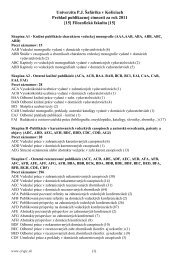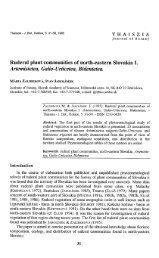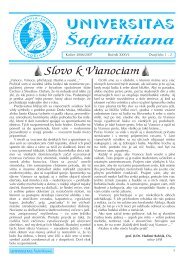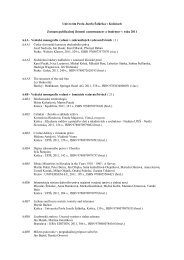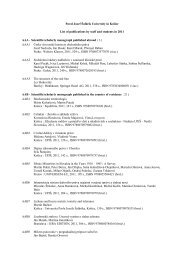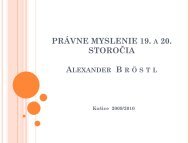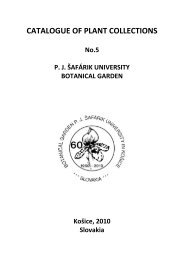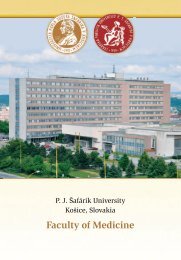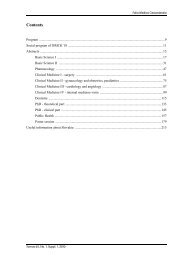full text
full text
full text
You also want an ePaper? Increase the reach of your titles
YUMPU automatically turns print PDFs into web optimized ePapers that Google loves.
Thaiszia - J. Bot., Košice, 12: 179-183, 2002<br />
http://www.upjs.sk/bz/thaiszia/index.html<br />
A range extension for Campanula moravica<br />
MILOSLAV KOVANDA<br />
179<br />
T H A I S Z I A<br />
JOURNAL OF<br />
BOTANY<br />
Academy of Sciences of the Czech Republic, Institute of Botany, 25243 Průhonice,<br />
Czech Republic<br />
KOVANDA M. (2002): A range extension for Campanula moravica. –<br />
Thaiszia – J. Bot. 12: 179-183. – ISSN 1210-0420<br />
ABSTRACT: Based on herbarium material from WU and LE,<br />
Campanula moravica (SPITZNER) KOVANDA is reported as new to<br />
four more provinces in Austria (Burgenland, Styria, Carinthia, Tyrol),<br />
Yugoslavia (Serbia), Bosnia and Herzegovina, Albania, Italy, the<br />
Ukraine, Byelorussia and Russia. The distinguishing characters are<br />
briefly discussed.<br />
Keywords: Campanula moravica, Campanula pinifolia, Campanula<br />
rotundifolia, Austria, Balkan Peninsula, the Ukraine, Byelorussia,<br />
Russia<br />
Since it was recognized as a distinctive member of the group Saxicolae of<br />
subsect. Heterophylla (WITAS.) FED. over thirty years ago (KOVANDA 1970,<br />
FEDOROV & KOVANDA 1976), our knowledge of Campanula moravica (SPITZNER)<br />
KOVANDA has made only slow progress. The species, at first considered to be<br />
only a local phenomenon, is now known to occur in the Czech Republic (from<br />
where it was described as a variety of C. rotundifolia L.; see SPITZNER 1893),<br />
Slovakia, Austria, Hungary, Croatia and Rumania (see FEDOROV & KOVANDA<br />
1976).<br />
C. moravica differs from C. rotundifolia especially in having a thickened<br />
rhizome, larger corollas (16-25 mm long), cauline leaves narrowly linear (at most<br />
1.8 mm wide) and more or less crowded in the lower part of the stem, a<br />
contracted inflorescence, a papillose ovary and a slightly lignified capsule. In<br />
national floras it is usually listed as C. rotundifolia.
The species, though distinctive, may be quite difficult to identify both in the<br />
field and in herbarium material, particularly to the untrained eye. The reason is<br />
threefold. First, the most conspicuous feature distinguishing it from C.<br />
rotundifolia, the thickened rhizome, is extremely fragile and almost impossible to<br />
unearth from a tangle of subterranean organs of other herbs. Hence it is only<br />
seldom available in herbarium specimens. Second, the papillose ovary of C.<br />
moravica is best seen in flower buds or young flowers. But the papillae can be<br />
missing, albeit rarely, in some buds or flowers, or, exceptionally, in whole plants<br />
of a population. On the other hand, papillae can occasionally be found in C.<br />
rotundifolia from the more southern parts of its distribution area. Third, the<br />
slightly lignified capsule is not available at all times. C. moravica starts to flower<br />
rather late (in Central Europe usually not earlier than 15 July) and capsules do<br />
not normally ripe until early September when field studies of the flora and<br />
vegetation are usually over.<br />
C. moravica includes two cytotypes, one tetraploid (2n=68), the other<br />
hexaploid (2n=102) that are impossible to distinguish safely on morphological<br />
grounds. Characters given for their recognition (diameter of rhizome, size of<br />
pollen grains) proved unreliable and apply to some plants only (KOVANDA 2000).<br />
The diploid cytotype (2n=34) is in turn distinguishable as a separate species C.<br />
gentilis KOVANDA but is not known to occur in the area of distribution of C.<br />
moravica (FEDOROV & KOVANDA 1976).<br />
My account of subsect. Heterophylla (WITAS.) FED. in Flora Europaea<br />
(FEDOROV & KOVANDA 1976) was based primarily on my field studies in Central<br />
Europe (Czech Republic, Slovakia, Poland, Austria, Germany) and the study of<br />
herbarium material from BRA, BRNM, BRNU, PR, PRC, W 1 and especially K<br />
where I spent nine and a half months working as a Flora Europaea bursar in<br />
1969-1970. It is the purpose of the present report to extend the knowledge of<br />
distribution of C. moravica by listing data that have ensued from my study of<br />
herbarium material kept in the herbaria of WU and LE which I was able to visit in<br />
2001.<br />
For the reasons set out above, the following list contains only specimens<br />
where I am quite sure that the plant concerned really is C. moravica (about one<br />
third of the material seen). It follows therefore that the species may be much<br />
more frequent than would appear from the list. Some collections from Austria,<br />
Yugoslavia and Bosnia (not from the more eastern countries) resemble C.<br />
gentilis (not previously reported), some are probably true C. rotundifolia s. str. To<br />
be absolutely sure, field studies are required.<br />
In localities from the Ukraine, Byelorussia and Russia, names of provinces<br />
(oblasť) were completed where missing, to facilitate their location. Abbreviations<br />
and symbols used: s.d. ... sine dato (no date given), ? ... name of collector<br />
missing or illegible. Phrases in inverted commas are quotations from the labels.<br />
1 Abbreviations of herbaria follow HOLMGREN P. K., HOLMGREN N. H. & BARNETT L. C.:<br />
Index Herbariorum, ed. 8, New York 1990.<br />
180
Austria<br />
Lower Austria: “Schwansdorf: zwischen lichten Gebüsch u. sparl. Graswuchs,<br />
neben einer gemähten Wiese”, Witasek 1910 WU; “unteres Kemptal, 2 Km SE<br />
von Schiltern an der Bundesstrasse nach Langenlois E der Kote 374, 370 m”, Till<br />
1996 WU; “in ditione oppidi Wiener Neustadt”, Kerner s.d. WU; “in incultis pr.<br />
Vindobonam (Brigittenau)”, Beck 1893 WU.<br />
Burgenland: “ober Neudörfl gegen Sauerbrunn”, Sonklar 1863 WU; “Mischwald<br />
südl. von Sauerbrunn, längst des grünmarkt. Weges nach Wien”, Leonhardt<br />
1960 WU.<br />
Styria: “in graminosis prope Gross-Lobming c. 640 m”, Pernhofer s.d. WU; “in<br />
graminosis silvaticis prope monasterium Geckau 850 m”, Pernhofer 1891 WU;<br />
“Judendorf, Frauenkogel”, Klammerth 1902 WU; “an Rainen bei Riez”, Korbeck<br />
s.d. WU.<br />
Carinthia: “Grauth am Bach”, Lütkemüller 1880 WU; “Mariasaal bei Klagenfurt”,<br />
Witasek 1898 WU; “Mollbrücken”, Witasek 1898 WU; “an Felsen bei<br />
Mollbrücken”, Wibiral 1910 WU; “Rosental, Waidischbach-Gries SW Otrouza E<br />
Ferlach, Bachschotter”, Leute 1993 WU.<br />
Tyrol: “Imst, Böschung an der Strasse nach Brennbichl”, Witasek 1900 WU.<br />
Yugoslavia<br />
Serbia: “auf Felsen prope Pirot”, ? 1889 WU; “Pirot, in m. Basara”, Adamović<br />
1898 WU; “in pascuis alp. m. Metina”, Adamović 1895 WU; “in pascuis subalp.<br />
m. Stara Planina”, Adamović 1896 WU.<br />
Bosnia and Herzegovina<br />
Bosnia: “Vlašic”, Brandis 1886 WU; “auf dem Udrĉ bei Drinjaĉa”, ? 1890 WU;<br />
“Crvene stijene bei Srebrenica”, Wettstein 1890 WU; “Radkoviĉi bei Granovo,<br />
am steinigen Hange des Jedovnica”, Handel-Mazzetti 1904 WU; “Mt. Ilica,<br />
Felsen gegen Westen”, Handel-Mazzetti & Janchen 1904 WU; “im Graben unter<br />
der Ogujavica vrelo an der Plaženica bei Bugojno”, Handel-Mazzetti & Janchen<br />
1904 WU; “Podkraj südöstlich von Livno”, Faltis & Wibiral 1907 WU.<br />
Albania<br />
“distr. Hasi: Pastrik, Gipfelregion, grasige, felsige Hänge, 1800 m”, Dörfler 1918<br />
WU.<br />
Italy<br />
“in rupestribus montis Resegone di Lecco”, Degen 1894 WU.<br />
181
The Ukraine<br />
Zakarpatska o.: “selo Jasiĉa, lug na Ĉornoj Tisse”, Popov 1946 LE.<br />
Ľvivska o.: “Umgebung von Lemberg [Ľviv], Sammler unbekannt”, c. 1860, WU.<br />
Žitomirska o.: “Olevsk, distr. Ovruĉ”, Paczoski 1894 LE; “Ovruĉskij rajon, okolo<br />
sela Gladkoviĉi”, Charkieviĉ 1947 LE.<br />
Černigovska o.: “distr. Krolovec, circa Budiĉa”, Borĉen 1897 LE; “luga bl.<br />
Konjatina”, ? 1913 LE.<br />
Kyjivska o.: “Kyjiv”, ? 1849; “Borodjanskij rajon”, Charkieviĉ 1969 LE.<br />
Dnipropetrovska o.: “praesertim circa urbem Mogiliv”, Dovnar 1862 LE.<br />
Byelorussia<br />
Minskaja o.: “Drozdy”, Ostankov 1863 LE.<br />
Gomelskaja o.: “Rogaĉevskij ujezd, dolina r. Dniepra”, Poliansky 1923 LE.<br />
Russia<br />
Tambovskaja o.: “Tambovskij rajon, pos. Goldši”, Buchalo 1974 LE.<br />
Discussion<br />
In Austria, C. moravica has so far been reliably known only from Lower Austria<br />
(KOVANDA 1970, FEDOROV & KOVANDA 1976, ADLER & al. 1994). The present<br />
data extend its range to four more provinces (Bundesländer), Burgenland, Styria,<br />
Carinthia and Tyrol. So far, no records are available for Upper Austria, Salzburg<br />
and Vorarlberg.<br />
The presence of C. moravica in much of the Balkan Peninsula could have<br />
been anticipated. Some collections from Serbia and Bosnia were seen and<br />
named C. pinifolia UECHTRITZ by the monographer WITASEK. Unfortunately, this<br />
is a nomen seminudum having been published in a footnote to C. rotundifolia in<br />
PANĈIĆ (1874) and diagnosed only vaguely with three words (in Serbian): "leaves<br />
narrow, numerous". WITASEK (1902) could have validated the name had she<br />
clearly indicated what she had in mind. But her description of C. pinifolia<br />
UECHTRITZ confuses at least two different species belonging to two different<br />
series: series Vulgares ("rhizoma tenue, ... receptaculum glabrum, ...") and<br />
series Saxicolae ("folia ... caulina linearia, inferne conferta, contracta").<br />
Moreover, she failed to indicate the taxonomic rank clearly and unambigously,<br />
having treated her C. pinifolia UECHTRITZ first as a species but then as a<br />
subspecies of C. rotundifolia (though using a binom) in a synopsis of her work<br />
(WITASEK 1902).<br />
It will be seen from the above list that by far the largest area extension for C.<br />
moravica is the Ukraine, Byelorussia and the western part of European Russia.<br />
One may perhaps wonder why these data were not included in Flora Europaea<br />
182
where the chief author of Campanula was Professor A. A. FEDOROV (1908-1987),<br />
then a staff member at the V. L. Komarov Institute of Botany, Academy of<br />
Sciences, St. Petersburg. The reason is simple. We worked quite independently,<br />
we never met, and only exchanged a couple of formal letters. He did not interfere<br />
with my part (subsect. Heterophylla), never showing any interest in my work, and<br />
I in turn, thirty years his junior, never found courage to meddle with his. My<br />
impression was that he was <strong>full</strong>y involved in his part of Campanula and was not<br />
inclined to extend his commitment. Nonetheless, our accounts were finally both<br />
accepted, edited and amalgamated by the editors and published. Neither has<br />
ever met with any serious criticism.<br />
Acknowledgements<br />
My sincere thanks go to the Keepers of the herbaria WU and LE who kindly<br />
placed their collections at my disposal. The financial support from the Russian<br />
Academy of Sciences is grate<strong>full</strong>y acknowledged.<br />
References<br />
ADLER W. & al. (1994): Exkursionsflora von Österreich. – Stuttgart & Wien.<br />
FEDOROV A. A. & KOVANDA M. (1976): Campanula L. – In: Tutin T. G. & al. (eds.): Flora<br />
Europaea 4: 74-93. - Cambridge, London, New York & Melbourne.<br />
KOVANDA M. (1970): Polyploidy and variation in the Campanula rotundifolia complex. Part<br />
II. (Taxonomic). 1. Revision of the groups Saxicolae, Lanceolatae and Alpicolae in<br />
Czechoslovakia and adjacent regions. - Folia Geobot. Phytotax. 5: 171-208.<br />
KOVANDA M. (2000): Campanulaceae Juss. - zvonkovité. – In: SLAVÍK B. (ed.), Květena<br />
Ĉeské republiky 6: 719-748. - Praha.<br />
PANĈIĆ J. (1874): Flora Kneževine Srbije. - U Beogradu.<br />
SPITZNER V. (1893): Floristische Mittheilungen. - Ver. Naturforsch. Ver. Brünn 31: 193-<br />
200.<br />
WITASEK J. (1902): Ein Beitrag zur Kenntnis der Gattung Campanula. - Abh. Zool. Bot.<br />
Ges. Wien 1/3: 1-106.<br />
183<br />
Received: 6 May 2002<br />
Revised: 30 October 2002<br />
Accepted: 31 October 2002




